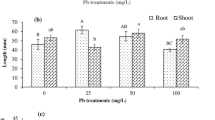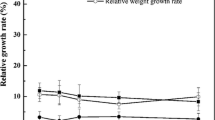Abstract
Phytoremediation offers a cheap, efficient and environmentally friendly option for cleaning sites contaminated with toxic elements. However, there is a need to find new plant species for phytoremediation and to understand the mechanisms involved in processes such as tolerance, accumulation, exclusion and metabolism of toxic metals in plants. Thereby, in this study, the ability of Acacia farnesiana (L.) Willd to tolerate and accumulate lead was analyzed. Seedlings grown in vitro with 250 and 500 mg Pb2+ L−1 showed an increase in their growth, achieving tolerance indexes close to 100%. In seedlings exposed to 1,000 mg Pb2+ L−1, growth was strongly inhibited, finding an effective concentration 50% (EC50) from 720 to 766 mg Pb2+ L−1. A. farnesiana accumulated ≥80% of the Pb2+ in roots (up to 51,928 mg kg−1 of air-dried tissue) in seedlings exposed to 1,000 mg Pb2+ L−1, with high bioconcentration (>8.5) and low translocation (≤0.03) factors. These results indicate the suitability of A. farnesiana for lead-phytostabilization purposes. Lead concentrations below 500 mg L−1 had no significant effect on lipid peroxidation and enhanced the glutathione content, suggesting that the ability of A. farnesiana to withstand the Pb-induced oxidative stress could be related to glutathione metabolism.





Similar content being viewed by others
Abbreviations
- ROS:
-
Reactive oxygen species
- MS:
-
Murashige & Skoog
- EDTA:
-
Ethylene-diamine-tetraacetic acid
- EU:
-
Experimental unit
- FW:
-
Fresh weight
- ADW:
-
Air-dried weight
- TI:
-
Tolerance index
- EC50 :
-
Effective concentration 50%
- BCF:
-
Bioconcentration factor
- TF:
-
Translocation factor
- GR:
-
Glutathione reductase
- MDA:
-
Malondialdehyde
- DTNB:
-
5,5′-dithiobis-2-nitrobenzoic acid
- TNB:
-
5-thio-2-nitrobenzoic acid
- GSHT :
-
Total glutathione
- GSH:
-
Reduced glutathione
- GSSG:
-
Glutathione disulfide (oxidized glutathione)
References
Akerboom TP, Sies H (1981) Assay of glutathione, glutathione disulfide, and glutathione mixed disulfides in biological samples. Meth Enzymol 77:373–382
Apel K, Hirt H (2004) Reactive oxygen species: metabolism, oxidative stress, and signal transduction. Annu Rev Plant Biol 55:373–99
Audet P, Charest C (2007) Heavy metal phytoremediation from a meta-analytical perspective. Environ Pollut 147:231–237
Baker AJM (1987) Metal tolerance. New Phytol 106(s1):93–111
Barkay T, Schaefer J (2001) Metal and radionuclide bioremediation: issues, considerations and potentials. Curr Opin Microbiol 4:318–323
Blokhina O, Virolainen E, Fagerstedt KV (2003) Antioxidants, oxidative damage and oxygen deprivation stress: a review. Ann Bot 91:179–194
Brunner I, Luster J, Günthardt-Goerg MS, Frey B (2008) Heavy metal accumulation and phytostabilisation potential of tree fine roots in a contaminated soil. Environ Pollut 152:559–568
Calabrese EJ, Bachmann KA, Bailer AJ, Bolger PM, Borak J, Cai L, Cedergreen N, Cherian MG, Chiueh CC, Clarkson TW (2007) Biological stress response terminology: integrating the concepts of adaptive response and preconditioning stress within a hormetic dose–response framework. Toxicol Appl Pharmacol 222:122–128
Cañedo-Ortiz BO, Perez-Reyes ME, Perez-Molphe E (2000) Somatic embryogenesis and plant regeneration in Acacia farnesiana and A. schaffneri. In Vitro Cell Dev Biol - Plant 36:268–272
Collin VC, Eymery F, Genty B, Rey P, Havaux M (2008) Vitamin E is essential for the tolerance of Arabidopsis thaliana to metal-induced oxidative stress. Plant Cell Environ 31:244–257
Del Rio D, Stewart AJ, Pellegrini N (2005) A review of recent studies on malondialdehyde as toxic molecule and biological marker of oxidative stress. Nutr Metab Carbiovasc Dis 15:316–328
Deng H, Ye ZH, Wong MH (2006) Lead and zinc accumulation and tolerance in populations of six wetland plants. Environ Pollut 141:69–80
Dey SK, Dey J, Patra S, Pothal D (2007) Changes in the antioxidative enzyme activities and lipid peroxidation in wheat seedlings exposed to cadmium and lead stress. Braz J Plant Physiol 19:53–60
Diwan H, Khan I, Ahmad A, Iqbal M (2010) Induction of phytochelatins and antioxidant defence system in Brassica juncea and Vigna radiata in response to chromium treatments. Plant Growth Regul, 61: doi:10.1007/s10725-010-9454-0
Esterbauer H, Cheeseman KH (1990) Determination of aldehydic lipid peroxidation products: malonaldehyde and 4-hydroxynonenal. Methods Enzymol 186:407–421
Francis JK (2002) Acacia farnesiana (L.) Willd. In: Vozzo JA (Ed.) Tropical Tree Seed Manual. Part II—Species Descriptions. USDA Forest Service, Washington DC, Agricultural Handbook, 721. 899 pp
Freeman JI, Persans MW, Nieman K, Albrecht C, Peer W, Pickering IJ, Salt DE (2004) Increased glutathione biosynthesis plays a role in nickel tolerance in Thlaspi nickel hyperaccumulator. Plant Cell 16:2176–2191
Gadd GM (2000) Bioremedial potential of microbial mechanisms of metal mobilization and immobilization. Curr Opin Biotechnol 11:271–279
Geebelena W, Vangronsvelda J, Adriano DC, Van Poucke LC, Clijsters H (2002) Effects of Pb-EDTA and EDTA on oxidative stress reactions and mineral uptake in Phaseolus vulgaris. Physiol Plantarum 115:377–384
Gratão P, Polle A, Lea PJ, Azevedo RA (2005) Making the life of heavy metal-stressed plants a little easier. Funct Plant Biol 32:481–494
Göthberg A, Greger M, Holm K, Bengtsson BE (2004) Influence of nutrient levels on uptake and effects of mercury, cadmium, and lead in water spinach. J Environ Qual 33:1247–1255
Imlay JA (2008) Cellular defenses against superoxide and hydrogen peroxide. Annu Rev Biochem 77:755–776
Klassen SP, Malean JE, Grossl PR, Sims RC (2000) Heavy metals in the environment. J Environ Qual 29:1826–1834
Kuiper I, Lagendijk EL, Bloemberg GV, Lugtenberg BJJ (2004) Rhizoremediation: a beneficial plant–microbe interaction. Mol Plant-Microb Interact 17:6–15
Liu D, Zou J, Meng Q, Zou J, Jiang W (2009) Uptake and accumulation and oxidative stress in garlic (Allium sativum L.) under lead phytotoxicity. Ecotoxicology 18:134–143
Meagher RB (2000) Phytoremediation of toxic elemental and organic pollutants. Curr Opin Plant Biol 3:153–162
Mench M, Schwitzguébel JP, Schroeder P, Bert V, Gawronski S, Gupta S (2009) Assessment of successful experiments and limitations of phytotechnologies: contaminant uptake, detoxification and sequestration, and consequences for food safety. Environ Sci Pollut Res 16:876–900
Meyer AJ (2008) The integration of glutathione homeostasis and redox signaling. J Plant Physiol 165:1390–1403
Mittler R (2002) Oxidative stress, antioxidants and stress tolerance. Trends Plant Sci 7:405–410
Naumann B, Eberius M, Appenroth KJ (2007) Growth rate based dose–response relationships and EC-values of ten heavy metals using the duckweed growth inhibition test (ISO 20079) with Lemna minor L. clone St. J Plant Physiol 164:1656–1664
Nouairi I, Ben AW, Ben YN, Ben Miled DD, Ghorbal MH, Zarrouk M (2009) Antioxidant defense system in leaves of Indian mustard (Brassica juncea) and rape (Brassica napus) under cadmium stress. Acta Physiol Plant 31:237–247
Reddy AM, Kumar SG, Jyothsnakumari G, Thimmanaik S, Sudhakar C (2005) Lead induced changes in antioxidant metabolism of horsegram (Macrotyloma uniflorum (Lam.) Verdc.) and bengalgram (Cicer arietinum L.). Chemosphere 60:97–104
Rizzi L, Petruzzelli G, Poggio G, Vigna Guidi G (2004) Soil physical changes and plant availability of Zn and Pb in a treatability test of phytostabilization. Chemosphere 57:1039–1046
Rouhier N, Lemaire SD, Jacquot JP (2008) The role of glutathione in photosynthetic organisms: emerging functions for glutaredoxins and glutathionylation. Annu Rev Plant Biol 59:143–66
Schnoor JL, Licht LA, McCutcheon SC, Wolfe NL, Carreira LH (1995) Phytoremediation of organic and nutrient contaminants. Environ Sci Technol 29:318A–325A
Schützendübel A, Polle A (2002) Plant responses to abiotic stresses: heavy metal-induced oxidative stress and protection by mycorrhization. J Exp Bot 53:1351–1365
Sharma NC, Sahi SV, Jain JC (2005) Sesbania drummondii cell cultures: ICP-MS determination of the accumulation of Pb and Cu. Microchem J 81:163–169
Singh OV, Labana S, Pandey G, Budhiraja R, Jain RK (2003) Phytoremediation: an overview of metallic ion decontamination from soil. Appl Microbiol Biotechnol 61:405–412
Singh N, Ma LQ, Srivastava M, Rathinsabapathi B (2006) Metabolic adaptations to arsenic-induced oxidative stress in Pteris vittata L. and Pteris ensiformis L. Plant Sci 170:274–282
Smith IK, Vieweller TL, Thorne CA (1988) Assay of glutathione reductase in crude tissue homogenates using 5, 5′-dithiobis(2-nitrobenzoic acid). Anal Biochem 175:408–413
Sun Q, Ye ZH, Wang XR, Wong MH (2005) Increase of glutathione in mine population of Sedum alfredii: A Zn hyperaccumulator and Pb accumulator. Phytochemistry 66:2549–2556
Vangronsveld J, Herzig R, Weyens N, Boulet J, Adriaensen K, Ruttens A, Thewys T, Vassilev A, Meers E, Nehnevajova E, van der Lelie D, Mench M (2009) Phytoremediation of contaminated soils and groundwater: lessons from the field. Environ Sci Pollut Res 16:765–794
Verma S, Dubey RS (2003) Lead toxicity induces lipid peroxidation and alters the activities of antioxidant enzymes in growing rice plants. Plant Sci 164:645–655
Volke Sepulveda TL, Velasco JA, de la Rosa DA (2005) Suelos contaminados por metales y metaloides: muestreo y alternativas para su remediación. Instituto Nacional de Ecología - Secretaría de Medio Ambiente y Recursos Naturales (INE-SEMARNAT). ISBN: 968-817-492-0. 141 pp
Wang C, Wang X, Tian Y, Xue Y, Xu X, Sui Y, Yu H (2008) Oxidative stress and potential biomarkers in tomato seedlings subjected to soil lead contamination. Ecotox Environ Safe 71:685–691
Acknowledgments
We would like to acknowledge to Consejo Nacional de Ciencia y Tecnologia (CONACyT) for its financial support in part of this research. A. Maldonado-Magaña also thanks CONACyT for the financial support (scholarship 211555).
Author information
Authors and Affiliations
Corresponding author
Additional information
Responsible Editor: Juan Barcelo.
Rights and permissions
About this article
Cite this article
Maldonado-Magaña, A., Favela-Torres, E., Rivera-Cabrera, F. et al. Lead bioaccumulation in Acacia farnesiana and its effect on lipid peroxidation and glutathione production. Plant Soil 339, 377–389 (2011). https://doi.org/10.1007/s11104-010-0589-6
Received:
Accepted:
Published:
Issue Date:
DOI: https://doi.org/10.1007/s11104-010-0589-6




